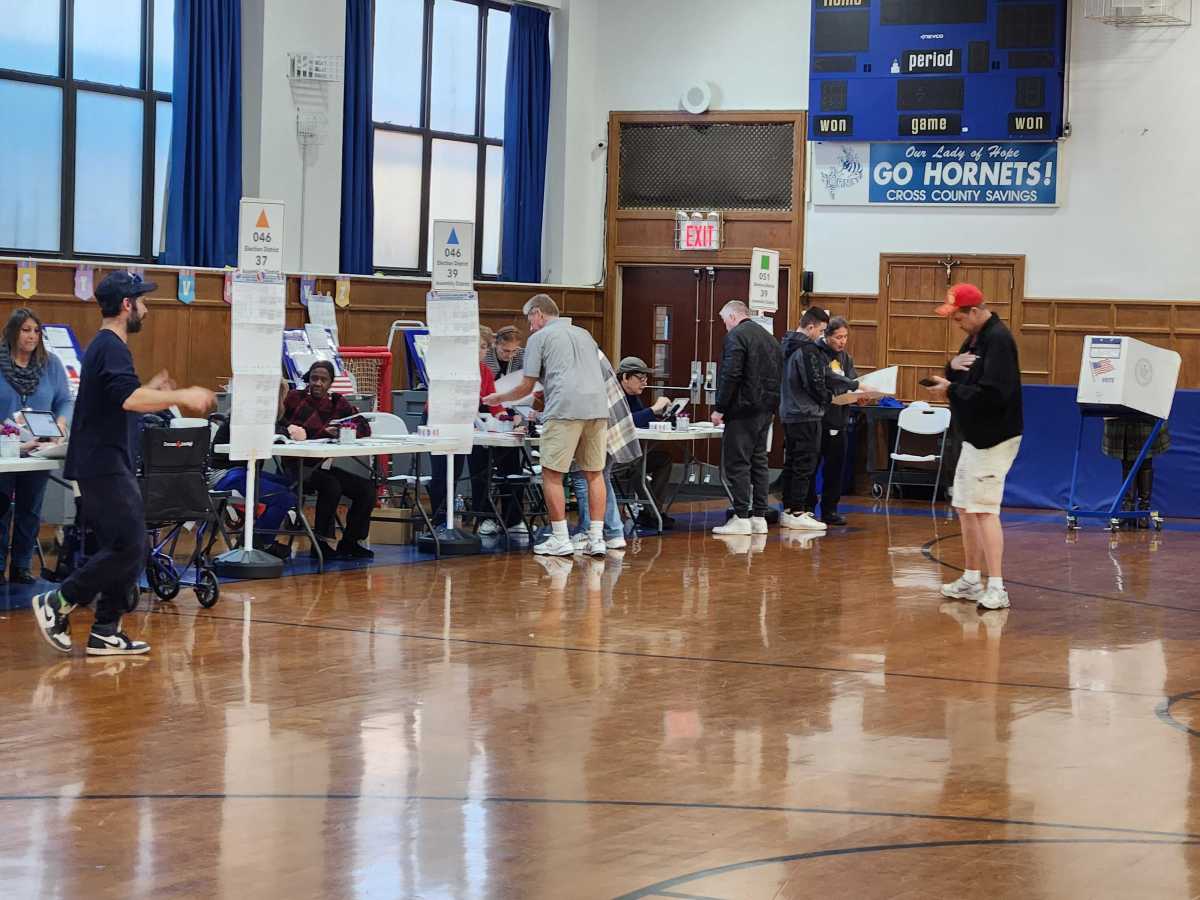BY ALINE REYNOLDS
As digital reach expands, a vow to retain brick and mortar appeal
Originally designed to revive a neighborhood traumatized by 9/11, the Tribeca Film Festival has become a global phenomenon that draws film lovers from around the world — and now reaches countless others on the web.
Founded in 2002, the festival started out as a five-day local affair with less than 150 screenings. “It was just a celebration to get people down here, and to bring new life [to Downtown],” said Genna Terranova (a senior programmer who joined the curatorial team in 2008).
“People didn’t know what Tribeca was about,” recalled David Kwok, the festival’s director of programming and one of its original full-time staff members. “[The festival] is something that, through a lot of relationships and just general growth and exposure, began gaining its own reputation.”
In its 10th season, the festival will present more than 500 screenings of feature films, documentaries and shorts. Last year, the festival stretched its tentacles into the digital realm by introducing a selection of films to cable and Internet viewers who can’t attend a live screening or who simply prefer watching movies at home.
But will the festival’s manifold expansions spoil the local, neighborhood vibe it once championed? Has the initial aim of helping out a shattered community been forgotten?
“The community is first and foremost one of the most important things of the festival,” said Terranova. “As you grow, there are other aspects that are important. But [9/11] is still a part of who we are. I don’t think that’ll ever change.” In an effort to serve Downtown residents, Terranova and her team are kick-starting the 10th season with a free public screening, at the World Financial Center, of Cameron Crowe’s documentary “The Union” — about the collaboration of legendary musicians Elton John and Leon Russell in producing the 2010 album of that name.
“It’s a good way for us to kind of come back in our 10th year and remind everybody that this is where we started,” said Kwok.
In order to streamline the line-up, the programmers decided to consolidate the films into fewer sections this year, according to type — Spotlight, Viewpoints, World Documentary Feature Competition, World Narrative Feature Competition and Cinemania. “We really want to celebrate the films and filmmaking and didn’t want to put [as many] lines between them,” explained Kwok.
The festival booklet was significantly pared down in 2008, when the curators slashed the title count from nearly 200 to less than 100 movies in an effort to make the program more manageable for both the staff and the viewers. “I think it makes the program more concise and approachable,” said Terranova. But it makes the programmers’ job more challenging, forcing the team to be more selective when judging the more-than 5,600 submissions this year in just six months.
“The program has to be molded in such a way that we’re picking the strongest movies possible available to us at this time. It’s tough to make those decisions,” said Terranova, acknowledging — and perhaps comforted by – the imperfect nature of the task. “Sometimes, you miss things. It’s part of human nature,” she said.
Terranova was previously a film buyer for The Weinstein Company and Miramax. “As a programmer, you have to use more of a fine-tooth comb in the process — you have first eyes on it, and no one already validated it for you,” she said of her new position. Curating the festival, she added, has refined her palette and deepened her appreciation of global cinema.
The programmers don’t have a set agenda when choosing the films for the festival — rather, they notice recurring themes following the decisions. This year, the team discovered that many of the movies are about subordinates contending with institutions (“Semper Fi: Always Faithful” recounts individual marines’ struggle for justice against the Marine Corps; and “Black Butterflies” tells the story of South African poet Ingrid Jonker, who bravely protests against Apartheid in her personal, expressive verse). Several other films feature musical icons, such as Ozzy Osbourne, Harry Belafonte and the Kings of Leon.
The festival is offering four films on video-on-demand this year, and 24 others with timed virtual screenings on the Internet. The movies chosen for cable TV and the Internet target a different audience than do those shown at the venues, the programmers said, and illustrate the power of social media. (“Flowers of Evil,” for example, demonstrates how citizens can coordinate social uprisings — and staying tuned to them remotely — via YouTube and Twitter.)
The festival’s new distribution division, the programmers assured, is not solely a profit-making venture. “I think it comes more from filmmakers [who wish] to give other filmmakers another platform,” said Terranova. “As a purely financial model, who knows if it’ll survive.”
“We wanted to figure out how we could extend this outside of 12 days, to expand the idea of what a festival can do,” Kwok explained.
The digital venture, he noted, is still a work in progress. “We want to see how people react to it,” said Kwok, “and see what works and what doesn’t.” As they do each year, the programmers will convene at the end of the festival to discuss how things went.
Irrespective of the distribution service’s success, Kwok and his team are intent on keeping the brick and mortar festival not only alive but developing and thriving.
“I don’t think demand of the festival itself will change,” he said. “There’s nothing you can really do to replicate the experience of going to the cinema with festival-goers.”
“If there were an unlimited amount of people watching the movies [from home], that might be cause for concern,” echoed Terranova, pointing out the limited options of the digital services. “We’re careful to want to preserve the event of being inside a cinema with a group of people. It’s one of the reasons why festivals continue to exist, because people want the communal experience.”
And this “communal” appeal has undoubtedly contributed to its success and fame. However, the festival still doesn’t have a place to call home. It lacks a central hub for its screenings and operations — something, Kwok said, that the staff has wanted from the get-go. “We wish we could have a whole complex for ourselves, where you have 20-25 screens, plus a place for our premieres and hospitality. That would be amazing,” said Kwok.
Instead, it hosts screenings in venues scattered around Lower Manhattan. Spreading outside of the triangular-shaped area below Canal Street was something the founders intentionally avoided early on. In the first season, they held screenings at Pace University, Stuyvesant High School and other local venues so as not to expand above 14th Street.
The current programmers, however, see an advantage in stretching north. “It helps different neighborhoods to sort of have the benefit of having the festival nearby,” said Terranova, in what she referred to as “spreading the love.” And, while the festival caters to an audience far wider than Downtown Manhattan, Kwok said he and his crew have not lost sight of its roots and its faithful neighborhood viewers.
“We’re very conscious of films that are set in New York or Downtown,” said Kwok, such as “Limelight” — a documentary about the New York club scene; and “Newlyweds,” which was shot entirely in Tribeca.
9/11 in particular, Terranova maintained, is still an integral part of the festival’s identity. “New York Says Thank You,” for example, tracks the journey of New York firefighters and volunteers helping communities nationwide revive from disasters. And the short “Current (Reprise)” documents New York City’s first ticker-tape parade following the World Trade Center attacks. The festival is also showing a free screening of “The Second Day,” a documentary highlighting interviews with teachers and students from Lower Manhattan schools about their harrowing experiences on 9/11.
The festival’s future, Kwok explained, is unpredictable, since it is inextricably tied to technological advances. “Who knows what’ll happen in two years — not just in terms of us, but in terms of how we’ll watch movies,” he said.
After all, the iPad, which was introduced last April, within months became a popular movie-watching device and further discouraged the need to leave one’s home to watch a film. Kwok, however, is confident the festival will survive these changes. “The great thing about being a young festival,” he said, “is that we can adapt very easily.”
The festival occurs from April 20 through May 1. For screening dates/times, ticket purchase and other festival-related information, visit www.tribecafilm.com/festival.
































